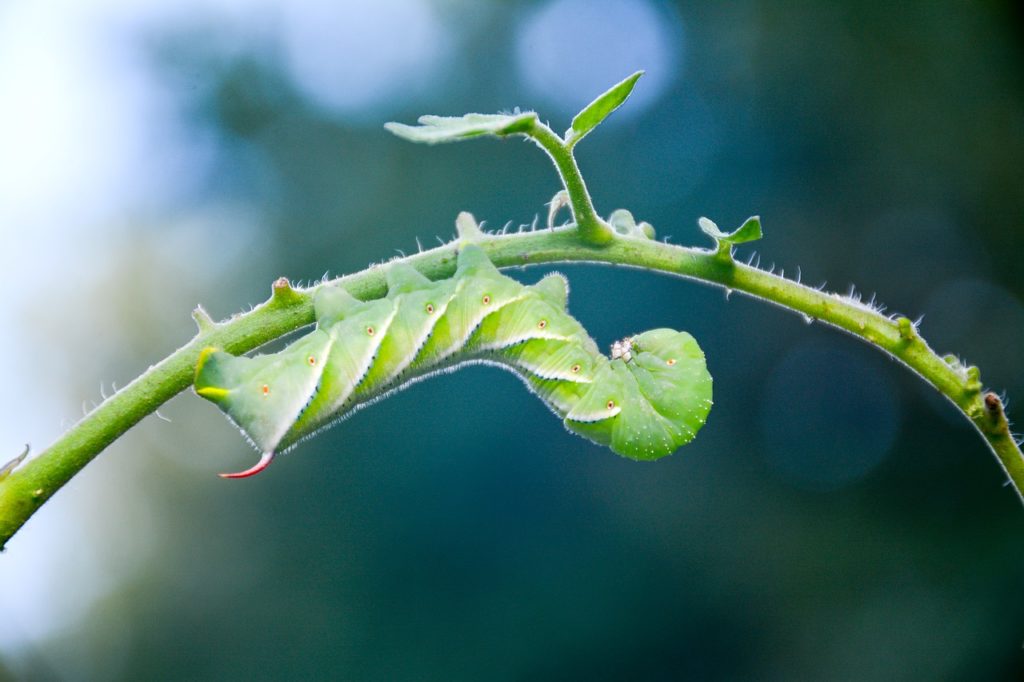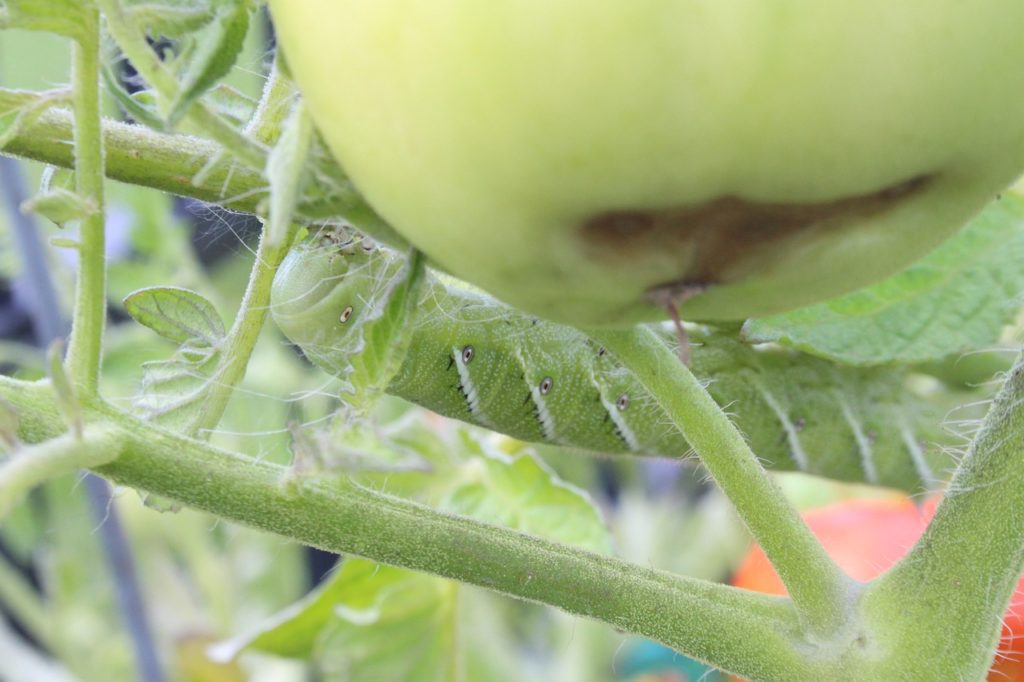Tomato hornworms love eating your tomatoes, but they also love nibbling on peppers, potatoes and eggplant. Not only do they nibble on these and other plants, but they’ll eat the entire plant if left on their own.
A lot of gardeners have problems with tomato hornworms and reach for the chemical-filled over-the-counter bug killers to solve the problem. The good news is, you can now choose alternatives that are much kinder to the environment.

What Are Tomato Hornworms?
Tomato hornworms are found nearly everywhere in North America and are devastating garden pests. Scientifically, they are known as Manduca quinquemaculata, and they have voracious appetites, eating the fruits, leaves, and even the stems of all types of plants.
The tomato hornworm is about four inches long and is therefore a rather large insect, but ironically they are sometimes difficult to find on your plants. This is because they have camouflage coloring that makes them practically unnoticeable in your garden.
The tomato hornworm looks a lot like a large caterpillar and is named because it has a large horn, usually in either red or black, protruding from its rear. Tomato hornworms are actually baby heavy-bodied moths, which grow up to have a wingspan about five inches in length.
They are usually called hawk moths or sphinx moths, and they have white stripes or brown spots when they’re fully grown. They are also fast-flying and tend to hover much the same way that hummingbirds do.
How to tell that plant damage is a Tomato Hormworm
Hornworm damage can look similar to damage caused by other pests. To know that it is tomato hornworm damage, look out for larvae among the plants, and sometimes even black droppings. They usually come out at either dusk, dawn or during the night to feed.
Hornworms are difficult to get rid of because they are found only in gardens, are will not naturally in other areas of land. They tend to stay in gardens because they need broad leaves and soft soil to survive. This is why they are so difficult to eliminate from your garden.
Why Tomato Hornworms So Bad for Your Garden
Tomato hornworms have huge appetites, have two life cycles per year and reproduce quickly, it doesn’t take long for them to overtake and destroy your garden. They leave droppings everywhere as they eat, and they start with the leaves of the plants then turn to feeding on the upper portions. It won’t take them long to eat the entire plant.
Moths from the Tomato Hornworm emerge in late spring, and these adults mate and leave eggs on the undersides of leaves.
In just five days, the eggs will hatch, and they reach their full growth at about four weeks when the larvae will burrow back into the soil.
The moth versions of the hornworm, or the sphinx moth are harmless. These grown moths feed on nectar from flowering plants and are simply not interested in vegetables.

Natural Ways to Get Rid of Tomato Hornworms
If you are interested in getting rid of tomato hornworms the natural way, check out these six easy methods.
1. Handpicking
This is one of the easiest ways to get rid of tomato hornworms, but you’ll have to be diligent in your approach. Some people find that they’re picking off their hornworms two to three times per day at least four or five days during the week.
Always wear garden gloves and gently flick them into a bucket. You can then feed them to your chickens or put them into your outdoor garbage can.
2. The Right Insects
Some insects will eat the eggs of the hornworms, which means that they’ll never have the chance to hatch and do damage to your plants. Some of these insects include lacewings and ladybugs, as well as common wasps, paper wasps, and braconid wasps. Make sure that you introduce the insects early enough to allow them to establish control in the garden.
3. Diatomaceous Earth
Diatomaceous earth is nontoxic and made up of tiny aquatic organisms that are fossilized. It isn’t harmful to people but kills insects as soon as they walk over it, and all you have to do is sprinkle some all around your garden for it to be effective.
4. Natural Pesticides
Two of the most common natural pesticides include spinosad and Bacillus thuringiensis (BT). BT is a natural bacterium found in the soil, and when tomato hornworms consume it, their digestive system is paralyzed. Therefore, they stop feeding and eventually die.
5. Plants Deterrents
Certain plants will deter the moths from laying eggs, and if there are no eggs, there is nothing to eat and destroy your vegetables. Try plants such as marigolds, dill, chamomile, basil, wildflowers, and buckwheat for great results.
6. Till The Soil
Since pupae bury themselves in the soil, tilling the soil easily gets rid of them by destroying them with the tiller. This method can easily get rid of up to 90% of the pupae located in your soil.
- How to Prevent Tomato Hornworms
Even if the method you choose is effective, there is still a possibility that your hornworms will come back so preventative measures are highly recommended. Below are some actions that you can take to reduce the possibility of tomato hornworms being a regular in your garden.
- Remove their food source by rotating your crops and getting rid of certain species, such as tomatoes and bell peppers.
- Weed your garden on a regular basis. This essentially removes the sites where these pests can overwinter and lay their eggs.
- Set traps for them. Traps to attract tomato hornworms usually have a blacklight that lures these pests in, and you can either kill them or release them to another location after they’re caught.
Six Ways to Get Rid of Tomato Hornworms Naturally Summary
Tomato hornworms are best eliminated by the handpicking method, but if you don’t like that option, try a natural method like plant deterrents or soil tilling. Tomato hornworms are large caterpillars that can devastate your plants. Deal with them quickly to save your harvest.
Happy growing.
I am an accredited practicing dietitian, experienced gardener and a dedicated cook. I love writing and sharing my experience so you can learn from my successes and mistakes.
